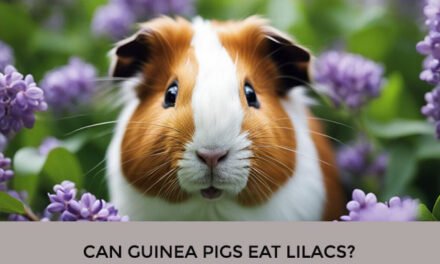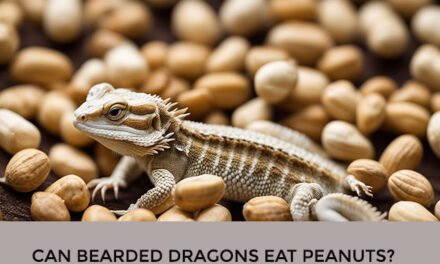Many guinea pig owners are always looking for ways to diversify their pets’ diet and provide them with a variety of fresh foods. Sugar snaps are a popular vegetable among humans, and it’s natural to wonder if guinea pigs can eat them too. In this article, we will explore whether sugar snaps are safe for guinea pigs to eat and what nutritional benefits they provide.

Guinea pigs are herbivores, which means they require a diet that is rich in fiber and low in fat and sugar. While fruits and vegetables are an essential part of their diet, not all of them are safe for guinea pigs to eat. Some vegetables can cause digestive problems, while others may be toxic to them. Therefore, it’s important to know which foods are safe and which ones to avoid. In the next section, we will discuss whether sugar snaps are a safe food for guinea pigs and what precautions you should take when feeding them.
Nutritional Profile of Sugar Snaps
Sugar snaps, also known as sugar snap peas, are a type of edible podded pea that are often consumed as a snack or included in salads and stir-fries. They are a good source of several essential vitamins and minerals, as well as dietary fiber.
Vitamin Content
Sugar snaps are particularly high in vitamin C, which is essential for maintaining a healthy immune system and promoting the absorption of iron from plant-based foods. In fact, just one cup of sugar snaps provides over 100% of the daily recommended intake of vitamin C.
They are also a good source of vitamin K, which plays a key role in blood clotting and bone health. One cup of sugar snaps provides approximately 20% of the daily recommended intake of vitamin K.
Fiber and Sugar Levels
Sugar snaps are low in calories and high in dietary fiber, making them a great option for those looking to maintain a healthy weight or improve their digestion. One cup of sugar snaps contains approximately 3 grams of fiber, which is about 12% of the daily recommended intake.
While sugar snaps do contain some natural sugars, they are relatively low in total sugar content. One cup of sugar snaps contains approximately 3 grams of total sugar.
Overall, sugar snaps are a nutritious and tasty addition to any diet. They are a great source of essential vitamins and minerals, as well as dietary fiber, and can be enjoyed in a variety of different ways.
Health Benefits of Sugar Snaps for Guinea Pigs

When it comes to feeding our guinea pigs, we always want to ensure that we are providing them with a balanced diet that includes a variety of fresh vegetables. Sugar snaps, also known as sugar snap peas, are a great option to consider adding to your guinea pig’s diet. Here are some of the health benefits of sugar snaps for guinea pigs:
Digestive Health
Sugar snaps are a great source of fiber, which is essential for maintaining a healthy digestive system in guinea pigs. Fiber helps to prevent constipation and other digestive problems by promoting regular bowel movements. Additionally, the fiber in sugar snaps can help to support the growth of beneficial bacteria in the gut, which can improve overall digestive health.
Weight Management
Maintaining a healthy weight is important for the overall health and well-being of guinea pigs. Sugar snaps are a low-calorie vegetable that can be a great addition to a guinea pig’s diet. They are also a good source of protein, which can help to keep guinea pigs feeling full and satisfied. By incorporating sugar snaps into your guinea pig’s diet, you can help them maintain a healthy weight and prevent obesity-related health problems.
Overall, sugar snaps are a nutritious and tasty vegetable that can provide many health benefits for guinea pigs. As with any new food, it’s important to introduce sugar snaps gradually and monitor your guinea pig for any signs of digestive upset. By providing your guinea pig with a balanced diet that includes a variety of fresh vegetables, you can help them maintain optimal health and well-being.
Risks of Feeding Sugar Snaps to Guinea Pigs

When it comes to feeding guinea pigs, it’s important to consider the nutritional value and potential risks of any food. Sugar snaps, also known as sugar snap peas, are a popular vegetable that many people enjoy. But can guinea pigs eat sugar snaps? Let’s explore the potential risks of feeding sugar snaps to guinea pigs.
Sugar Content Concerns
Sugar snaps contain a moderate amount of sugar, which can be a concern for guinea pigs. While guinea pigs need some sugar in their diet, too much can lead to health problems such as obesity, diabetes, and dental issues. It’s important to monitor the amount of sugar your guinea pig consumes, including the sugar found in vegetables like sugar snaps.
Potential for Allergic Reactions
Some guinea pigs may be allergic to sugar snaps or other vegetables. Signs of an allergic reaction can include itching, swelling, and difficulty breathing. If you notice any of these symptoms after feeding your guinea pig sugar snaps, it’s important to stop feeding them immediately and contact your veterinarian.
In conclusion, while sugar snaps can be a tasty treat for guinea pigs, it’s important to monitor their sugar intake and watch for any signs of allergic reactions. As always, consult with your veterinarian before making any changes to your guinea pig’s diet.
Feeding Guidelines
Recommended Serving Size
When it comes to feeding sugar snaps to guinea pigs, it is important to keep in mind that they should only be given in moderation. The recommended serving size for sugar snaps is about one or two small pieces per day, depending on the size of your guinea pig. It is important to note that feeding too many sugar snaps can lead to digestive problems and obesity in guinea pigs.
Frequency of Feeding
While sugar snaps can be a healthy addition to a guinea pig’s diet, it is important to not overfeed them. We recommend feeding sugar snaps to your guinea pig no more than once or twice a week. It is important to provide a balanced diet for your guinea pig that includes hay, fresh vegetables, and a small amount of pellets.
When feeding sugar snaps to your guinea pig, it is important to wash them thoroughly and remove any strings or tough parts. You can serve them raw or lightly steamed, but avoid cooking them with oil or seasoning. Always monitor your guinea pig’s reaction to new foods and consult with a veterinarian if you have any concerns about their diet or health.
Alternative Healthy Snacks for Guinea Pigs
As responsible pet owners, we always want to make sure that our furry friends are getting the best possible nutrition. While sugar snaps may be tempting to feed to our guinea pigs, it’s important to remember that they should only be given in moderation due to their high sugar content. Luckily, there are plenty of other healthy snack options that we can give to our guinea pigs.
Vegetables and Fruits
Guinea pigs are herbivores, which means that their diet should consist mainly of hay, fresh vegetables, and fruits. Some great options for healthy snacks include:
- Carrots: These are a great source of vitamin A and can also help keep your guinea pig’s teeth healthy.
- Bell peppers: These are high in vitamin C and come in a variety of colors, making them a fun and colorful addition to your guinea pig’s diet.
- Apples: These should be given in moderation due to their high sugar content, but they are a great source of fiber and vitamin C.
- Blueberries: These are a great source of antioxidants and can also help boost your guinea pig’s immune system.
When giving your guinea pig fruits and vegetables, it’s important to remember to wash them thoroughly and remove any seeds or pits.
Commercial Guinea Pig Treats
In addition to fresh fruits and vegetables, there are also a variety of commercial guinea pig treats available on the market. Some options include:
- Timothy hay cubes: These provide your guinea pig with a crunchy snack while also helping to keep their teeth healthy.
- Oxbow Simple Rewards: These come in a variety of flavors and are made with all-natural ingredients.
- Kaytee Timothy Biscuits: These are a great source of fiber and come in a variety of flavors.
When choosing commercial guinea pig treats, it’s important to read the ingredients list and make sure that they are made with high-quality, all-natural ingredients. Avoid treats that are high in sugar or contain artificial preservatives or flavors.
By providing our guinea pigs with a variety of healthy snack options, we can help ensure that they are getting the nutrition they need to stay healthy and happy.
Frequently Asked Questions
What vegetables can guinea pigs eat on a daily basis?
Guinea pigs require a diet that is rich in Vitamin C, fiber, and other essential nutrients. They can eat a variety of vegetables on a daily basis, including leafy greens like lettuce, spinach, and kale. Other safe options include bell peppers, cucumbers, and zucchini.
Are carrots a safe addition to a guinea pig’s diet?
Yes, carrots are a safe addition to a guinea pig’s diet. They are an excellent source of Vitamin A and fiber, which are essential for their overall health. However, carrots should be given in moderation as they are high in sugar.
Is it safe for guinea pigs to consume pea pods?
Yes, guinea pigs can consume pea pods. However, they should be given in moderation as they are high in sugar. It is also important to remove the strings from the pea pods before feeding them to your guinea pig.
Can guinea pigs have sweet peas as part of their diet?
Sweet peas are safe for guinea pigs to consume in moderation. However, they should be given without the pods as they are too tough for their teeth to chew.
Are baby corns an appropriate food choice for guinea pigs?
Yes, baby corns are an appropriate food choice for guinea pigs. They are low in calories and high in fiber, making them a healthy snack option.
Is it okay for guinea pigs to eat green beans and other legumes?
Yes, guinea pigs can eat green beans and other legumes in moderation. However, it is important to remove the strings from the green beans before feeding them to your guinea pig. Legumes should also be given in moderation as they are high in protein.





